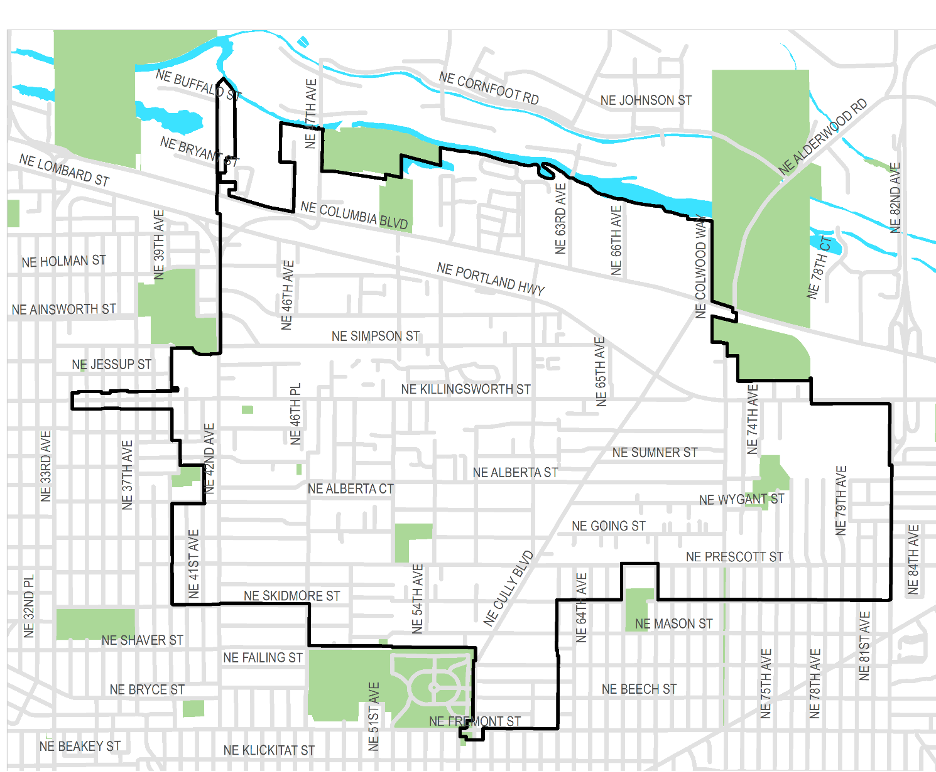
For more than a decade, the city has recognized the fragile diversity and affordability of Portland’s Cully Neighborhood. With a unanimous vote on Wednesday, city officials took a major step forward in preserving that diversity with a plan one commissioner called a “legacy project.”
The Portland City Council’s decision this week created a new Cully Tax Increment Finance, or TIF, District. The community-crafted urban renewal area is expected to bring in up to $350 million over its 30-year life. While TIF districts have been around for decades, and used widely to spur development throughout Portland, this plan has a different mission: to stabilize those most vulnerable to displacement.
“Cully is a very special part of our city,” Portland Mayor Ted Wheeler said before voting. “It’s the city’s most culturally and ethnically diverse community and it’s facing significant displacement pressures right now. These TIF resources will fund housing and economic development projects that will help address some of those pressures and move the community closer toward its vision.”
In other Portland neighborhoods, TIF districts have ushered in gentrification and displacement for communities of color and people with low incomes. The Cully plan creates a new template for neighborhood investment and anti-displacement work, designed to protect it against the very market forces TIF has historically exacerbated.
“It’s an exciting project and it really doubles down on the city’s and community’s collective investment in the Cully Neighborhood in Northeast Portland,” said Commissioner Dan Ryan, who oversees the city’s housing bureau.
Cully history of affordability has fostered a widely diverse population, but it has lost 50 percent of its Black population over the past decade, and its average household income is 24 percent lower compared to Portland, with more members under one roof relying on that income. In the Cully neighborhood alone, the median family income for Black households is less than half that of their White counterparts, according to city statistics. Nearly 40 percent of Black residents in Cully live below the poverty level.
A decade ago, the Portland City Council passed a resolution to study and prevent displacement in Cully, which was to that point considered historically underfunded. Efforts by two Neighborhood Prosperity Districts helped prioritize investments to prevent business closures and create affordable housing opportunities, but not enough to keep market forces at bay.
Despite brownfields, limited public transit, poor walkability, and a lack of open recreational space, among other challenges, housing prices in Cully have accelerated like the rest of the Portland market. Today, the median sales price for a home in Cully hovers around $500,000 — 7.4 percent over last year — according to realtor.com and Redfin.
Unique about the Cully TIF District is its community-based origins. Seven organizations — The Native American Youth and Family Center (NAYA), Hacienda CDC, Habitat for Humanity Portland Region, Verde, the Cully Association of Neighbors, and the two overlapping Neighborhood Prosperity Districts — Our 42nd Avenue, the Cully Boulevard Alliance — crafted the plan in cooperation with the city. That plan was further refined by public engagement meetings with members of the community in a process that spanned four years.
“This TIF district will benefit people in Cully, but hopefully the benefits will extend way beyond the neighborhood by showing an example of using this resource in an innovative way that is truly community-led,” said Matina Kauffman, vice president of homeownership & neighborhood programs with Habitat for Humanity Portland Region.
Ryan and Wheeler acknowledged those community members and nonprofits, including Habitat, for their extensive work on the proposal.
“It was quite a community effort, and it was actually very gratifying to be in the meetings with all of you and to hear about all that you went through to get to this point of time,” Ryan said. “It’s a legacy project. I’m proud to vote ‘aye.’”
Commissioner Jo Ann Hardesty said she was skeptical of the project at first, having seen the negative outcomes of previous TIF districts in Portland. But she said she was swayed by the commitment of Cully community members.
Guidelines built into the TIF proposal are explicit on how to invest the revenue with the primary goal of preventing the displacement of vulnerable people and preserving and creating new opportunities for affordable housing and economic prosperity.
The plan specifically identifies the priority communities it is intended to benefit: African American and Black persons; Indigenous and Native American persons; persons of color; immigrants and refugees of any legal status; renters; mobile home residents; persons with disabilities; low-income people; houseless people; and other population groups that are systemically vulnerable to exclusion from Cully due to gentrification and displacement.
It also prioritizes a sequence to investments, with initial investments going toward stabilizing residents and businesses, buying land for affordable housing development, and then later investing in quality-of-life improvements, such as a community center. In accordance with city TIF policy, at least 45% of all TIF resources generated in the Cully District will be allocated for affordable housing.
The next step in the district’s development is the creation of the Community Leadership Committee, or CLC. Membership will be drawn from Cully stakeholders who will provide guidance in TIF spending. All Committee members must either live, work, worship, volunteer, have children enrolled in school, or have been displaced from within the Cully TIF District boundary. The CLC will provide analysis and input on funding decisions, which will be decided by the city’s development commission, Prosper Portland, and City Council. Prosper Portland is ultimately responsible for distributing the funds and administering all TIF districts in Portland.
For more information on this proposal, the process, and answers to frequently asked questions, visit the Prosper Portland Cully TIF site.


